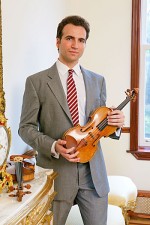Column Name
Title
Subhead
Sitting in the Louis XV–appointed living room of Sean Carpenter’s Manhattan townhouse, one is reminded of a bygone era where musicians and composers sat side by side with politicians, businessmen, and celebrities to enjoy performances and discussions of music, art, and culture. But while the age of the Salon de Musique is long gone, musician and now violin entrepreneur Carpenter regularly hosts performances at his home, and he is passionate about bringing classical and contemporary music and society back into alignment.
Body
“I had been interested in instruments—the way they were constructed, how different they sound, the differences in the styles of makers—from a very young age,” the 29-year-old Carpenter recently told The Journal. While most boys had posters of cars and athletes, depictions of Stradivarius and Guarneri del Gesù violins covered Carpenter’s walls while he was growing up in Great Neck, Long Island. He started studying violin at age 6 and spent three years at Juilliard’s Pre-College, where he studied with Louise Behrend. Yet despite his love for instruments and performing, Carpenter chose not to attend a conservatory, instead earning degrees in politics from Princeton University and the University of Cambridge. After graduating, he returned to the music world and competed in, among others, the prestigious 2005 Queen Elisabeth Competition. But in 2007, Carpenter once again left performing to join the financial world, working for Fortress Investment Group and Further Lane Securities in New York City. This past April, he combined his expertise in finance and business with his knowledge of instruments, musicians, and collectors, to establish Sean A. Carpenter Fine Violins, LLC.
Carpenter’s goal is to focus less on profits than on bringing together the players of fine instruments with the collectors and owners of fine instruments. The recent high-profile sale of the Molitor Stradivarius to violinist Anne Akiko Meyers for a record-breaking $3.6 million has been well documented. While Carpenter views this as positive evidence that “the market for fine instruments remains strong despite the recession, and shows that there continues to be a great interest in the preservation of these instruments,” he has little interest in breaking sales records. Instead, he strives to represent the best interests of the seller, the buyer, and the instrument itself. For this reason, he only works with instruments of the highest caliber and condition, often turning away high quality instruments with imperfections and damages.
This work ethic, along with his personal interests and background, allows Carpenter to appreciate the many nuances of an instrument—especially those that might be underappreciated by other types of collectors. Most players naturally have an immediate response to an instrument’s quality of sound, tone, and timbre, while many collectors and admirers are as captivated by an instrument’s history—its owners, performers, and travels—as they are by its sound. While he’s undoubtedly mindful of an instrument’s tone quality and lineage, Carpenter devotes equal attention to the level of artistry embodied in the instruments themselves, and he views each one as a work of art. “If you look at the varnish on this,” he says looking over a late-period Stradivarius violin, “its rich color shows that it was applied very generously, while the same maker, 30 years earlier, typically used varnish much more sparingly. These little things make a difference in the instrument’s sound and also show something about its maker.”
Carpenter’s efforts to ensure the preservation of great instruments and his passion to bring a more contemporary audience to appreciate these instruments have led him to act as more of a facilitator than a businessman. He hopes, for instance, to “align new collectors and new buyers to the market with first-class soloists—players who are really at the top—and genuine people who have the same vision that I do in terms of preserving these instruments and maintaining and sharing them with the public.” One such alignment is a collaboration he is pursuing with the Metropolitan Museum of Art through which world-class performers can perform on the museum’s collection of instruments, allowing visitors the opportunity to appreciate the instruments’ aesthetic and tonal beauty.
Ultimately, Carpenter’s efforts to create relationships between collectors and buyers of instruments with great artists are part of a greater hope of reinvigorating the world of the arts within contemporary culture. The musical evenings he hosts in his living room and his return to the artistic world reflect this belief that classical arts and music can be as active a part of contemporary lives as they were for past generations.





